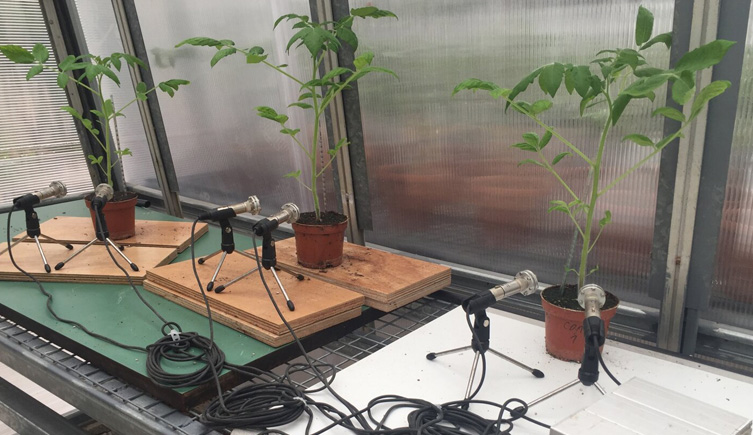Scientists have recorded plants producing airborne sounds in response to lack of water or having their stems damaged.
The ultrasonic pops occurred in rapid bursts, which differed depending on the type of stress the plant was experiencing.

Tomato and tobacco plants make rapid popping sounds in response to dehydration and having their stems cut. Image © Digihelion/Shutterstock.
Scientists have recorded plants producing airborne sounds in response to lack of water or having their stems damaged.
The ultrasonic pops occurred in rapid bursts, which differed depending on the type of stress the plant was experiencing.
What does a stressed plant sound like?
A bit like bubble wrap being popped, according to a new studyopens in a new window which reveals the plant world may not be as silent as commonly believed.
Researchers tested the response of tomato and tobacco plants to dehydration and having their stems cut and found they emitted sounds which are comparable in volume to normal human conversation.
While the frequency of these popping sounds is too high for human ears, insects, other mammals, and maybe even other plants can likely detect them.
The sounds were also found to differ depending on the type of stress the plant was experiencing, which could be distinguished using a machine learning algorithm.
Professor Lilach Hadany, an evolutionary biologist at Tel Aviv University and author of the study, says, 'Even in a quiet field, there are actually sounds that we don't hear, and those sounds carry information.'
'There are animals that can hear these sounds, so there is the possibility that a lot of acoustic interaction is occurring.'
This is one of the recordings captured by the research team of a tomato plant emitting popping sounds in response to stress.

Microphones picked up the sounds made by stressed plants up to five metres away. Image © Ohad Lewin-Epstein licenced under CC BY-SAopens in a new window.
Healthy and stressed plants were recorded using microphones in a soundproof acoustic chamber and a noisier greenhouse. They were stressed using two methods, not watering them for several days and cutting their stems.
Researchers found that stressed plants emitted 30-50 pops per hour, much more frequently than unstressed plants, which could be detected up to five metres away.
Water-stressed plants started emitting more rapid noises before visible signs of dehydration, such as the browning of leaves, began appearing. The sounds peaked after five days without water and dropped off as the plant dried up completely.
Interestingly, sounds were different depending on the cause of the stress. Researchers were able to train a machine-learning algorithm to accurately differentiate between unstressed plants, thirsty plants and cut plants. It could also tell which type of plant the sounds came from.
Tomato and tobacco plants were the main focus of the study as they are relatively easy to grow in a laboratory, but the team also recorded other plants.
‘We found that many plants - corn, wheat, grape, and cactus plants, for example - emit sounds when they are stressed,’ explains Lilach.

Stressed plants emitted 30-50 pops per hour, which was more than unstressed plants. Image © Khait et al. licenced under CC BY-SA.
Although the thought of plants making sounds in response to stress may seem like a cause for concern, there is currently no evidence suggesting that plants make these noises intentionally.
The precise mechanism behind the noises is unclear, but researchers suggest that it might be due to air bubbles forming and bursting in the plant's vascular system in a process called cavitation.
Dr Norbert Holstein, a botanist at the Museum who was not involved in the study, says, 'Many things emit sounds. For example, leaves rustling in the wind or the sounds a hungry tummy makes when the gut walls move against each other.'
'Creating sounds can happen unintentionally. Is this communication? Not necessarily.'
Scientists involved in the study believe the sounds created by plants may have significant ecological and evolutionary implications.
Previous research has shown that plants can respond to sounds and vibrations created by pollinators, which triggers them to increase sugar concentration in their nectar. But if and how other plants or animals may respond to acoustic signals from plants is not fully understood.
'Now that we know that plants do emit sounds, the next question is - who might be listening?' says Lilach. 'It's possible that other organisms could have evolved to hear and respond to these sounds.'
'For example, a moth that intends to lay eggs on a plant or an animal that intends to eat a plant could use the sounds to help guide their decision.'
'We are currently investigating the responses of other organisms, both animals and plants, to these sounds, and we're also exploring our ability to identify and interpret the sounds in completely natural environments.'

Just how weird can the natural world be?
Don't miss a thing
Receive email updates about our news, science, exhibitions, events, products, services and fundraising activities. We may occasionally include third-party content from our corporate partners and other museums. We will not share your personal details with these third parties. You must be over the age of 13. Privacy notice.
Follow us on social media